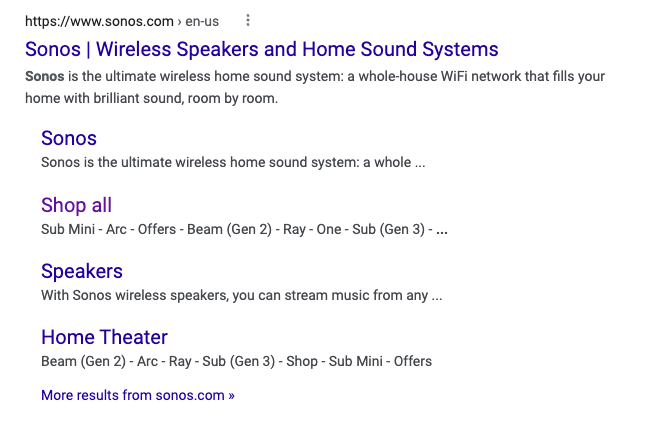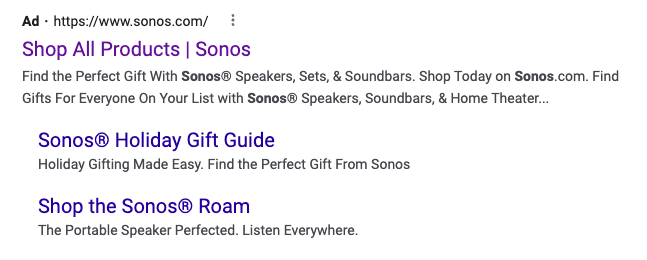There are a lot of dynamics that impact what appears on Google’s search engine results pages (SERPs).
In the current way that Google describes search results, SERPs can include text results, visual results, rich elements, exploration features, and more.
The larger the space and more real estate you can own in the SERPs, the better your chances of gaining the clicks and website traffic that you want from your target audience.
An important and often overlooked aspect of the SERPs, and your opportunity to gain visibility, is through sitelinks.
What Are Sitelinks?
Sitelinks are additional links or navigational elements for a specific website or domain that appear with a text result or ad result in the SERP.
More broadly, they are navigational in nature and allow searchers to see more of the ways they can click into your site.
In the current era of context-focused SEO and the emphasis on user engagement and experience (which I fully embrace and agree with), sitelinks are great ways to not just own real estate, but also to get important clicks and have users stick when they land on your site.
In organic search, Google’s algorithm only shows sitelinks for pages it deems relevant and useful to the user.
One of the benefits of sitelinks is that they can improve click-through rates (CTRs), as they increase the amount of real estate a text result has on the SERP. In doing so, they push down other results potentially below the fold, or out of view.
Sitelinks can improve the visibility of internal pages. Underperforming pages can see traffic improve if they appear as sitelinks on more popular pages.
Having sitelinks with your organic results and paid ads is an important opportunity that is often overlooked.
CTRs, getting users to stick around, and matching them up with the content they want from us are vital to success in SERPs.
Sitelinks can be a part of doing more with your positive rankings and further provide quality opportunities to searchers.
Types Of Sitelinks
There are several types of common sitelinks:
- Inline sitelinks.
- Expanded sitelink groups.
- Search box.
- Paid sitelinks.
Inline Sitelinks
Inline sitelinks are typically shown as four links in a horizontal row below the primary search result.
 Screenshot from Google, December 2022
Screenshot from Google, December 2022Expanded Sitelinks
The version that might come to mind first for you – as it does for me – is expanded sitelink groups.
Those take up the most real estate in the SERP and appear as a list underneath the primary text (or organic) result. They also include descriptions, which can be pulled from the meta description or text that Google has chosen relevant to the user’s search.
 Screenshot from Google, December 2022
Screenshot from Google, December 2022Search Box Sitelinks
A search box sitelink is a concise search box that appears below the primary text result. It allows users to access your site’s search engine directly.
 Screenshot from Google, December 2022
Screenshot from Google, December 2022Paid Sitelinks
These are tied to ads and are the most controllable by site owners.
Sitelinks can be created and added to relevant campaigns and ad groups and appear under the text ad link and primarily copy.
 Screenshot from Google, December 2022
Screenshot from Google, December 2022
Note that I have also seen other types of sitelinks in short-lived instances. A recent example was a horizontal, swipeable carousel of sitelinks on mobile that appears not to be active or in the wild anymore.
How To Get Sitelinks
There’s no way to tell Google to show site links or to add or delete them directly.
However, you do have specific ways that you can take action and implement best practices to try to get them and manage them indirectly.
Text Link Sitelinks Best Practices
For organic opportunities, the best practices for getting sitelinks under a text result start with using informative, relevant, and concise page titles and headings on your website.
You’ll also want a site structure that users and bots can efficiently navigate.
That means making sure the important and relevant pages are being linked to from the page. Utilizing breadcrumbs can also help Google understand the site’s structure, the relationship between pages, and the overall hierarchy.
Concise and relevant anchor link text is also important to factor into your site and efforts.
Other Sitelink Types
If you’re advertising through Google Ads, you can get sitelinks easily by adding them to your ad groups and campaigns.
The sitelinks search box might be an appealing and helpful tool for your site as well.
For a sitelinks search box to appear on your text result, you need to have a functional search engine on your site where user queries direct them to a search results page. You must also add WebSite structured data to the home page that defines the SearchAction.
How To Remove A Sitelinks Search Box
Conversely, to remove a sitelinks search box from your site, you simply add this meta tag to your homepage:
<meta name="google" content="nositelinkssearchbox">
Management
If an unwanted page is being shown as a sitelink, consider whether that page needs to be indexed altogether.
If it should be indexed but isn’t relevant to the page in the result, consider how it is being linked to on the page.
Through indexing and physical linking, you can have some control over getting pages out of your sitelinks if they don’t belong or aren’t relevant.
In the past, there were tools within Google Webmaster Tools (the precursor to Google Search Console) that would allow you to remove certain sitelinks, but those controls are gone. Now, your best bet is managing what links are actually on your site and how they are presented to users and search engines.
Conclusion
Owning as much real estate as possible in the SERPs for organic results is a key goal for SEO and can positively impact impressions and clicks to your site.
With many other competing types of non-organic content in the SERPs, you want to have as much visibility and control as possible.
Sitelinks can give you a larger space, pull users into deeper links on your site, and provide more context to searchers before they enter the site.
More resources:
- Why Isn’t Google Showing The Sitelinks I Want? Ask An SEO
- Internal Link Structure Best Practices to Boost Your SEO
- Core Web Vitals: A Complete Guide
Featured Image: MaximP/Shutterstock




